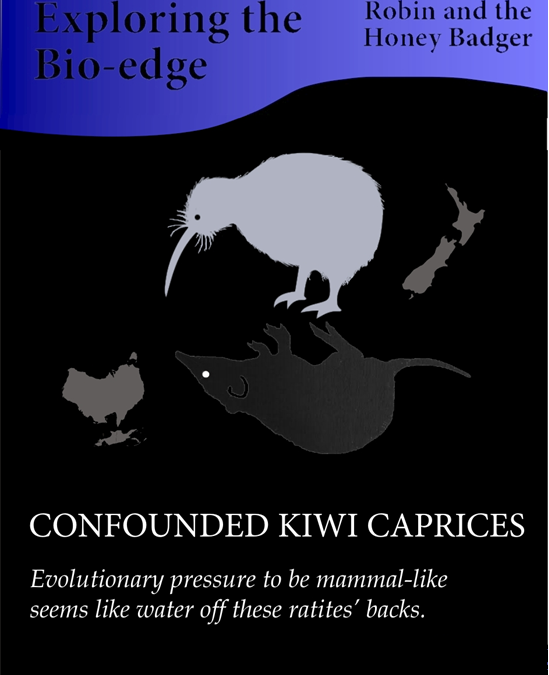 Note to readers: Biological Expositions is a series of blog-posts each of which is equivalent in content to a book chapter. If bio-bullets are likened to a starter, blog-posts could be seen as a light lunch and Biological Expositions as a three course meal. We look forward to your comments on this series.
Note to readers: Biological Expositions is a series of blog-posts each of which is equivalent in content to a book chapter. If bio-bullets are likened to a starter, blog-posts could be seen as a light lunch and Biological Expositions as a three course meal. We look forward to your comments on this series.
Evolutionary pressure to be mammal-like seems like water off these ratites’ backs.
One of those factoids of natural history is that kiwi are honorary mammals on one remote, mammal-free archipelago in the southwest Pacific. But in reality these birds have as many divergences as convergences with mammals, and much about kiwi seems to defy prediction based on the biogeography, evolution and biology of the world’s islands.
Here’s one example of the anomaly. The vestigial nature of the wings of kiwi is understandable on islands such as New Zealand where mammalian predators have been absent. This is because the most dangerous predator on New Zealand was a diurnal raptor, Haast’s eagle which, although being large enough to kill the ostrich-size flightless birds called moa, would have struggled to catch kiwi hiding in forest and undergrowth. But then why have kiwi also evolved for nocturnal activity? We would have predicted that hiding in the darkness – or for that matter underground – would be superfluous in a habitat so poor in predators that flight is unnecessary.
Along these lines, we’ll ask, ‘Which are the five biggest anatomical surprises about kiwi?’ and then we’ll think laterally to take some of the surprise out of them.
One surprise is that kiwi combine distal nostrils with a tactile organ at the tip of the beak.
What is both novel and counterintuitive in kiwi is that when foraging by sinking the beak deep into the earth there is a combination of distal smell and feeling. Certain waders do have a special organ of touch at the tip of a long beak that they use to probe the ground. But this organ is not used for olfaction so does not qualify as a nostril. Indeed, it’s well-known that no other bird – including other ratites – has nostrils at the tip of the beak. Other probers of soft soil, such as certain ibises, have neither feature; their nostrils open at the base of the beak, and their beak tip lacks a tactile organ. By contrast kiwi not only smell with the tip of their beaks, but also apparently use them as a kind of ‘white walking stick’ to feel for above-ground obstacles when negotiating the litter and undergrowth.
So the peculiarly perceptive probe possessed by kiwi is unpredicted by the birds’ mode of foraging, i.e. probing for buried earthworms and other invertebrates. And as for the notion of convergence with mammals: the combination of olfaction and touch at the tip of an elongated rostrum is only vaguely mammal-like in the sense in that some mammals, such as the bandicoots of Australia and New Guinea, have elongated noses used to probe litter and soil. Evolutionary forces on remote islands may generate unusual features in island faunas, but we should be able to formulate plausible rationales for the adaptive value of such features. In the case of this sniffing, sensitive beak, we’re left with the zoological equivalent of a wand. Where is an objective understanding of why such a beak would be desirable, necessary and competitive for a ground-dwelling bird in New Zealand?
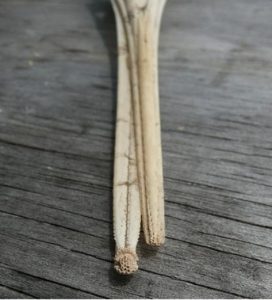
Figure 1. Kiwi showing pits for tactile organ at tip of beak bones in ventral view [photo by D. Craig under Creative Commons licence 2.0].
A second surprise is that kiwi combine extensive facial bristles with a long beak.
It may be no news to readers that more and longer vibrissal feathers occur in kiwi than in other birds. But again what’s odd is the combination, because these bristles cannot fulfil a tactile function for food items in the case of kiwi, even though this is their normal function in other birds. Probing deep into the soil precludes this.
Unlike the distal nostrils, the bristles – except possibly for those on the forehead – don’t categorically distinguish kiwi from other birds. But it’s only in kiwi that we find long vibrissal feathers too short to operate in direct conjunction with the mouth. To reiterate: the tactile organ used for foraging is located at the tip of the long beak, well beyond the longest bristle; and when the beak penetrates the ground the vibrissal feathers are incapable of following no matter how long they are. If, instead of feeling for food, the bristles of kiwi are used for sensing the confines in darkness underground, is this unique among burrowing birds? As far as we know, the answer is yes.
A third surprise is that kiwi combine advanced hatchlings with slow metabolism, reproduction and growth.
Again, it’s well-known that kiwi have remarkably large eggs and hatchlings so well-developed that their plumage is already of adult form. Although an ability of juveniles to forage for themselves from the start is normal for ratites, kiwi may possibly have the largest eggs of any vertebrate, living or extinct, in proportion to body size. This reproductive mode is surprising in an island fauna characterised by the slow pace of life – a characteristc in keeping with relative freedom from predation.
On mainlands, precocial birds such as plovers, thick-knees and coursers withstand intense predation pressure partly by reproducing and growing rapidly. In their precociality, kiwi are divergent from the most comparable metatherian mammals in Australia and New Guinea, particularly bandicoots and echidnas. In their degree of development at birth, kiwi could hardly differ more from the Antipodean marsupials and monotremes, which are extremely altricial.
A fourth surprise is that kiwi combine small eyes with feeling sensitively in the dark.
The eyes of kiwi are smaller than in any other nocturnal bird. It’s odd enough that kiwi have to some degree traded off the typical avian visual acuity for the specialised organs of touch of the long beak and facial bristles; but it’s doubly odd that kiwi generally emerge only in darkness on islands with relatively few predators. If there are few predators why don’t kiwi just forage by day?
Furthermore, there’s nothing particularly convergent with nocturnal mammals in this combination, because many nocturnal mammals have large eyes as well as facial bristles.

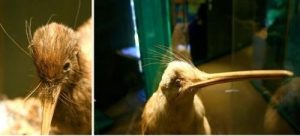
Figure 2. Kiwi showing vibrissal feathers [photos by T. Hunt under Creative Commons licence 2.0].
The flightlessness and poor eyesight of kiwi suggest a relaxation of predation pressure. Yet the great spotted kiwi goes to lengths to construct burrows, which are neither excavated with the beak nor have much to do with finding subterranean prey. Although various birds burrow for nesting, kiwi are among the most frequent and extensive of avian burrowers, in extreme cases excavating labyrinthine systems mainly for shelter. The great spotted kiwi seems to live virtually underground by day, with its resting locations being transient within an extensive territory.
Because the body form of kiwi differs radically from any burrowing mammal, any convergence between kiwi and mammals in the burrowing habit is superficial. Not only are kiwi unlikely to use the soft, sensitive beak-tip as a digging stick in emulation of burrowing woodpeckers and bee-eaters, but they dig with claws unemployed as scratchers during foraging. With their combination of extreme length of beak-plus-neck and extreme brevity of tail, we can imagine kiwi almost bending over backwards to work inside horizontal burrows.

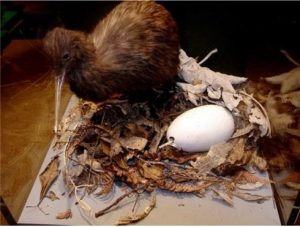
Figure 3. Kiwi showing relative size of egg [photo by B. Dieu under Creative Commons licence 2.0].
So, which are the five biggest anatomical surprises about kiwi? Our answer is as follows, not necessarily in order of importance: distal nostrils despite the tactile sensitivity at the tip of the beak, extensive facial bristles despite the length of the beak, extremely large eggs despite a slow pace of life, small eyes despite nocturnal activity, and a long neck despite burrowing with the feet.
Although much thought has been devoted to the conservation of kiwi, we may be the first to confront fully the paradox that these birds present for biological theory. Admittedly, it’s tempting to explain the peculiarities of kiwi according to the notion that – given a failure of land mammals to reach New Zealand – birds have emulated mammalian form and function. And this may fit the bill if one arbitrarily chooses criteria to show the convergence, such as flightlessness, body temperature, plumage form, sensory reliance on sniffing and vibrissal touch, and burrowing for refuge. We could even claim a particular convergence between kiwi and the long-beaked echidnas of New Guinea, pointing out that both bird and mammal lay eggs, have the shortest of tails, and use a probing, toothless rostrum with distal nostrils mounted on a head with small eyes and no ear pinnae.
However, even in this somewhat forced comparison of kiwi and long-beaked echidnas, kiwi are as divergent as they are convergent. For example, long-beaked echidnas have particularly developed forelimbs used for digging, a long, protrusible tongue, a lack of facial bristles, and altricial, not precocial, offspring.

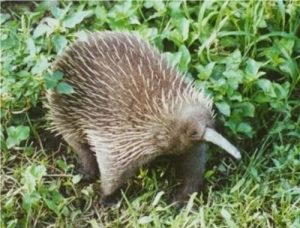
Figure 4. Long-beaked echidna, showing a mammal comparable with kiwi on the basis of occupying similar niches in New Guinea and New Zealand respectively [photo in the public domain].
The incongruousness we’ve described in kiwi seems to be borne out in a different framework: a comparison between New Zealand and southernmost South America. Tierra del Fuego and its nearby islands are, in a sense, the South American version of the Antipodes, with comparable landscape, geology and climate. These far-southern archipelagos have floristic links such as the southern beeches, and an austral fauna particularly poor in mammals. Is any bird convergent with kiwi in Tierra del Fuego, cheating kiwi of any of the five surprises we’ve listed?
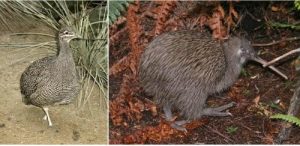
Figure 5. Elegant crested tinamou and southern brown kiwi, showing the great differences in body form between the South American ratite and the New Zealand ratite [photo by Stavenn (tinamou) and G. Fergus (kiwi) under the Creative Commons licence 2.0].
Tinamous, although superficially similar to game birds, are widely accepted to be related to kiwi in the same superorder. This relationship may not be as close as previously thought, because ratites are a category probably as much of convergence as of shared ancestry. Tinamous are broadly comparable to kiwi in terms of body size and shape: both have strong legs, short tail and small wings. They also share some other significant features, such as incubation by males, which is a typical of ratites. On the other hand, tinamous don’t have a long beak or facial bristles and, unlike other ratites, do fly, albeit weakly and reluctantly.
It seems reasonable to expect tinamous to have undergone local adaptation in Tierra del Fuego because there are 47 species of tinamous across a vast range from just north of the Tropic of Cancer in Mexico southwards to Patagonia. And we might also predict that any tinamou surviving in Tierra del Fuego would, by convergence with kiwi, have particularly small wings, particularly well-developed legs, and even possibly a particularly long beak with facial bristles.
But in fact no such convergence is evident, because no tinamou occurs south of the Magellan Straits. Tinamous are absent from the islands at the tip of South America and, as far as we know, no other animal resembles kiwi in Tierra del Fuego. Even the Patagonian tinamou of the southernmost mainland seems no more analogous with kiwi than tinamous living north of the equator. So these ratites don’t, after all, share any of the five surprises we’ve listed for kiwi despite their comparable biogeographical setting.

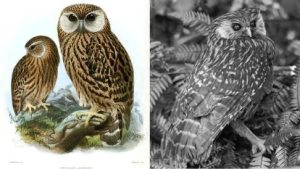
Figure 6. Laughing owl, showing a partly terrestrial bird of prey potentially acting as the main predator of kiwi before the extinction of the owl [images in the public domain].
What emerges instead is that kiwi seem incongruous based on existing assumptions. It’s hardly surprising that kiwi are restricted to New Zealand and morphologically unique, but the problem is that the actual form and function – indeed the whole adaptive syndrome of kiwi make little sense based on the assumption that it lived in the freedom from terrestrial predators that pertains to most of the world’s islands.

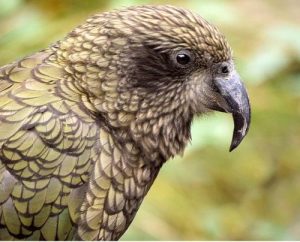
Figure 7. Kea, showing a parrot capable of killing other birds, potentially including kiwi [photo by T. Sobek under Creative Commons licence 2.0].
So maybe we should consider the possibility that New Zealand, a land almost as vast as California, had more terrestrial predators than met the eye.
The main suspect is a modest-sized but partly terrestrial owl, recently extinct. However, harm to kiwi could also have come from two unlikely sources: an aberrant omnivorous parrot called the kea and an aberrant omnivorous bat called the greater short-tailed bat. If our suspicions are sound, then nocturnality and burrowing might make sense in kiwi because bursting up in flight would be unlikely to evade any of these aggressors.
So how would kiwi have managed its predators? Refuge in burrows would probably have robbed the owl of its main advantages of superior eyesight and ability to pounce on to the back of kiwi to deploy its talons. This would level the playing field underground to a kicking match in pitch darkness, in which kiwi would have the tactile advantages of their beak and vibrissae, plus an ability to use their strong, if not particularly sharp-clawed, legs. Burrowing and nocturnal emergence would also have protected kiwi from the kea. The potential for the kea to have preyed on kiwi is easy to overlook because of the fact that this intelligent bird is versatile rather than specialised.
The last species to consider is the recently extinct New Zealand greater short-tailed bat, one of only a few genera of bats worldwide that are capable of locomoting rapidly on all fours on the ground and eating the tissues of animals much larger than themselves. Although too small to kill kiwi outright, this species is thought to have entered the nesting burrows of shearwaters to bite flesh from the juveniles of these birds. If done gregariously, this piecemeal carnivory would be lethal to kiwi, particularly the hatchlings.
We challenge biologists to face up to the anomalies of regarding the symbolic birds of New Zealand as would-be mammals, and to flesh out and scrutinise more realistic rationales. If this is done, we look forward to the possibility that kiwi will one day unsurprise us on all the five counts we’ve listed. Perhaps we’ll come to see how these birds are the predictable products of natural selection in this unique environment after all.
And our best guess, for now, is that a combination of Haast’s eagle, laughing owl, kea and greater short-tailed bat made – at least collectively – for a formidable predatory pressure on the ground. The refuge of kiwi, hypothetically, was to choose the dark, minimising exposure to the giant eagle and the dagger-beaked parrot, and to choose to dig, forcing the walking owl and the scurrying bat into straitjacketed confrontations in dark burrows with two strong, avian legs.
***
All text and images appearing in this blog are subject to copyright, except those images explicitly stated to be in the public domain. You are not free to use any photographs, for any purpose, without receiving written permission from the copyright holder
Casuarinaceae: Allocasuarina huegeliana, another tree native to southwest Australia

